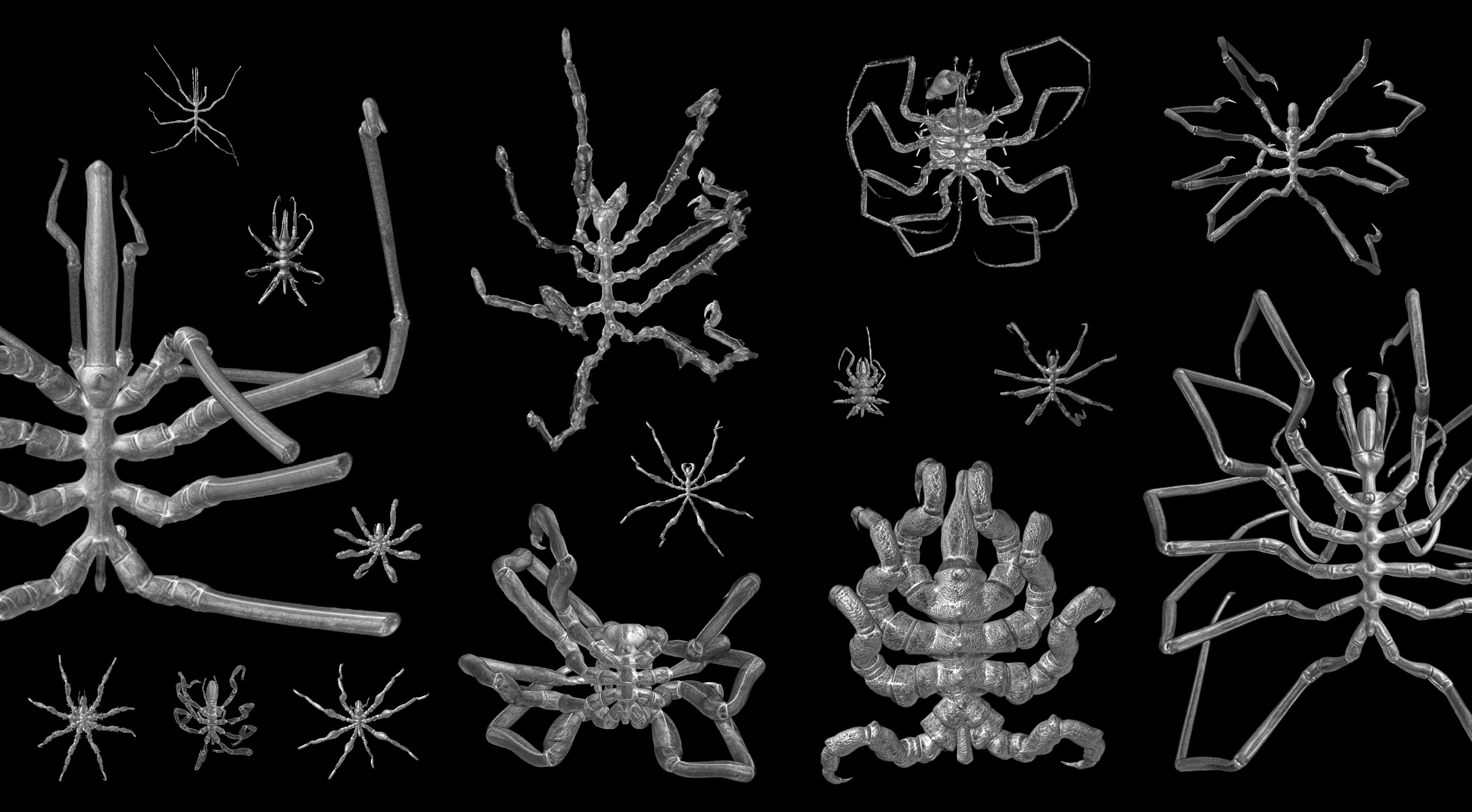
Dr. Georg Brenneis
Integrative Zoology
UBB, Djerassiplatz 1
1030 Vienna, Austria
room: 4.042
phone: +43 1 4277 76307
mail: georg.brenneis@univie.ac.at
Research
I am pursuing the integrative study of arthropod development, morphology and diversity in a phylogenetic and evolutionary framework. Among the countless arthropod taxa, I am particularly interested in sea spiders (Pycnogonida), which are the sister group of all other extant chelicerates (spiders, scorpions and their kin) and represent the only uncontested primary marine lineage among them.
Marine invertebrates group

Publications
Papadopoulos N, Kulkarni SS, Baranyi C, Fromm B, Setton EVW, Sharma PP, Wanninger A, Brenneis G (2025): "The genome of a sea spider corroborates a shared Hox cluster motif in arthropods with a reduced posterior tagma." BMC Biology 23: 196. → pdf
Klementz BC, Brenneis G, Laumer EM, Neu SM, Harvey MS, Sharma PP (2025): "Evolution and homology of leg segments in Chelicerata: Evo-devo solutions to century-old challenges." Arthropod Structure and Development 87: 101446. → journal's website
Klementz BC, Brenneis G, Hinne IA, Laumer EM, Neu SM, Hareid GM, Gainett G, Setton EVW, Simian C, Vrech DE, Joyce I, Barnett AA, Patel NH, Harvey MS, Peretti AV, Gulia-Nuss M, Sharma PP (2024): "A novel expression domain of extradenticle underlies the evolutionary developmental origin of the chelicerate patella." Molecular Biology and Evolution 41: msae188. → pdf
Arango CP, Brenneis G (2024): “Epimorphic development in tropical shallow‑water Nymphonidae (Arthropoda: Pycnogonida) revealed by fluorescence imaging” Zoological Letters 10: 1. → pdf
Brenneis G, Wagner D (2023): “Mating observation of giant sea spiders (Pycnogonida: Colossendeidae).” Marine Biodiversity 53: 45. → pdf
Brenneis G, Frankowski K, Maaß L, Scholtz G (2023): “The sea spider Pycnogonum litorale overturns
the paradigm of the absence of axial regeneration in molting animals.” Proceedings of the National
Academy of Sciences U.S.A. 120: e2217272120. → pdf
Frankowski K, Miyazaki, K, Brenneis G (2022): “A microCT-based atlas of the central nervous system and midgut in sea spiders (Pycnogonida) sheds first light on evolutionary trends at the family level.” Frontiers in Zoology 19: 14. → pdf
Brenneis G (2022): “The visual pathway in sea spiders (Pycnogonida) displays a simple serial layout with similarities to the median eye pathway in horseshoe crabs.” BMC Biology 20: 27. → pdf
Brenneis G, Schwentner M, Giribet G, Beltz BS (2021): "Insights into the genetic regulatory network underlying neurogenesis in the parthenogenetic crayfish Procambarus virginalis." Developmental Neurobiology 81: 939-974. → pdf
Brenneis G, Scholtz G (2021): "A postlarval instar of Phoxichilidium femoratum (Pycnogonida, Phoxichilidiidae) with an exceptional malformation." Journal of Morphology 282: 278-290. → pdf
Ballesteros JA, Setton EVW, Santibánez López, CE, Arango CP, Brenneis G, Brix S, Cano-Sánchez E, Dandouch M, Dilly GF, Eleaume MP, Gainett G, Gallut C, McAtee S, McIntyre L, Moran AL, Moran R, López-González PJ, Scholtz G, Williamson C, Woods HA, Wheeler WC, Sharma PP (2021): "Phylogenomic resolution of sea spider diversification through integration of multiple data classes." Molecular Biology and Evolution 38: 686-701. → pdf
Brenneis G, Arango CP, Sharma PP, Schwentner M (2020): "The more the merrier: unparalleled sympatric species richness in a sea spider genus (Pycnogonida, Callipallenidae, Pallenella) from Tasmanian waters." Invertebrate Systematics 34: 837-870. → journal's website
Brenneis G, Beltz BS (2020): “Adult neurogenesis in crayfish: origin, expansion and migration of neural progenitor lineages in a pseudostratified neuroepithelium.” The Journal of Comparative Neurology 528: 1459-1485. → pdf
Brenneis G, Arango CP (2019): “First description of epimorphic development in Antarctic Pallenopsidae (Arthropoda, Pycnogonida) with insights into the evolution of the four-articled sea spider cheliphore.” Zoological Letters 5: 4. → pdf
Brenneis G, Scholtz G, Beltz BS (2018): “Comparison of ventral organ development across Pycnogonida (Arthropoda, Chelicerata) provides evidence for a plesiomorphic mode of late neurogenesis in sea spiders and myriapods.” BMC Evolutionary Biology 18: 47. → pdf
Brenneis G, Bogomolova EV, Arango CP, Krapp F (2017): “From egg to “no-body”: an overview and revision of developmental pathways in the ancient arthropod lineage Pycnogonida.” Frontiers in Zoology 14: 6. → pdf
Beltz BS, Brenneis G, Benton JL (2016): “Adult neurogenesis: lessons from crayfish and the elephant in the room.” Brain Behavior and Evolution 87: 146-155. → journal's website
Scholtz G, Brenneis G (2016): “The pattern of a specimen of Pycnogonum litorale (Arthropoda, Chelicerata, Pycnogonida) with a supernumerary leg can be explained with the ‘boundary model’ of appendage formation.” The Science of Nature 103: 13. → pdf
Brenneis G (2016): “Pycnogonida (Pantopoda).” Book chapter in Structure and Evolution of Invertebrate Nervous Systems (Eds: Schmidt-Rhaesa A, Harzsch S, Purschke G), Oxford University Press, 776 p.
Brenneis G, Scholtz G (2015): “Serotonin-immunoreactivity in the ventral nerve cord of Pycnogonida – support for individually identifiable neurons as ancestral feature of the arthropod nervous system.” BMC Evolutionary Biology 15: 136. → pdf
Brenneis G, Scholtz G (2014): “The ‘ventral organs’ of Pycnogonida (Arthropoda) are neurogenic niches of late embryonic and post-embryonic nervous system development.” PLoS One 9: e95435. → pdf
Stegner MEJ, Brenneis G, Richter S (2014): “The ventral nerve cord in Cephalocarida (Crustacea) – new insights into the ground pattern of Tetraconata.” Journal of Morphology 275: 269-294. → journal's website
Brenneis G, Stollewerk A, Scholtz G (2013): “Embryonic neurogenesis in Pseudopallene sp. (Arthropoda, Pycnogonida) includes two subsequent phases with similarities to different arthropod groups.” EvoDevo 4: 32. → pdf
Arango CP, Brenneis G (2013): “New species of Australian Pseudopallene (Pycnogonida: Callipallenidae) based on live colouration, morphology and DNA.” Zootaxa 3616: 401-436. → journal's website
Brenneis G, Arango CP, Scholtz G (2011b): “Morphogenesis of Pseudopallene sp. (Pycnogonida, Callipallenidae) II: Postembryonic development.” Development, Genes and Evolution 221: 329-350. → journal's website
Brenneis G, Arango CP, Scholtz G (2011a): “Morphogenesis of Pseudopallene sp. (Pycnogonida, Callipallenidae) I: Embryonic development.” Development, Genes and Evolution 221: 309-328. → journal's website
Richter S, Loesel R; Purschke G, Schmidt-Rhaesa A, Scholtz G, Stach T, Vogt L, Wanninger A, Brenneis G, Döring C, Faller S, Fritsch M, Grobe P, Hausen H, Heuer CM, Kaul S, Møller OS, Müller CHG, Rieger V, Rothe BH, Stegner MEJ, Harzsch S (2010): “Invertebrate neurophylogeny: suggested terms and definitions for a neuroanatomical glossary.” Frontiers in Zoology 7:29. → pdf
Brenneis G, Richter S (2010): “Architecture of the nervous system in Mystacocarida (Arthropoda, Crustacea) – an immunohistochemical study and 3D reconstruction.” Journal of Morphology 271: 169-189. → journal's website
Brenneis G (2010): “Implikationen der Nervensystem-Entwicklung bei Asselspinnen (Arthropoda, Pycnogonida) für die segmentale Zusammensetzung der Kopfregion.“ Sitzungsberichte Gesellschaft Naturforschender Freunde zu Berlin (N.F.) 47: 135-150.
Brenneis G, Ungerer P, Scholtz G (2008): “The chelifores of sea spiders (Arthropoda, Pycnogonida) are the appendages of the deutocerebral segment.” Evolution and Development 10: 717-724. → journal's website
Brenneis G, Richter S (2008): “Immunohistochemical study and 3D reconstruction of the central nervous system of Mystacocarida (Arthropoda, Crustacea).” Journal of Morphology 269: 1481-1482; published abstract. → pdf
Brenneis G, Scholtz G (2008): “Brain development in sea spiders (Arthropoda, Pycnogonida) and the segmental association of their head appendages.” Journal of Morphology 269: 1465; published abstract. → pdf
